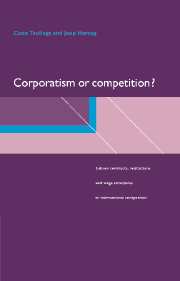 Corporatism or Competition?
Corporatism or Competition? Book contents
- Frontmatter
- Contents
- Preface
- Symbols and abbreviated references
- Synopsis
- 1 What we observe and what we claim
- 2 The role of corporatism in models of surplus sharing
- 3 Beliefs, norms and institutions
- 4 Union behaviour
- 5 Wage differentials and rent sharing
- 6 Tenure wage profiles
- 7 Unemployment and wage flexibility
- 8 Inside corporatism: how the Dutch play their game
- 9 An assessment: competition or corporatism?
- References
- Index
7 - Unemployment and wage flexibility
Published online by Cambridge University Press: 23 November 2009
- Frontmatter
- Contents
- Preface
- Symbols and abbreviated references
- Synopsis
- 1 What we observe and what we claim
- 2 The role of corporatism in models of surplus sharing
- 3 Beliefs, norms and institutions
- 4 Union behaviour
- 5 Wage differentials and rent sharing
- 6 Tenure wage profiles
- 7 Unemployment and wage flexibility
- 8 Inside corporatism: how the Dutch play their game
- 9 An assessment: competition or corporatism?
- References
- Index
Summary
Introduction
The most vehement complaint about corporatism is that it would reduce wage flexibility. The bureaucrats of the corporatist organizations would be less prone to adjust wages to market conditions than individual employers and employees. However, starting from the model developed in chapter 2, this is an all but obvious conclusion. Nominal contracts between firms and their workers are designed in order not to have to negotiate on wages every now and then. At the micro level, idiosyncratic shocks tend to be far more important than aggregate shocks. If parties try to avoid having to adjust time and again to the idiosyncratic shocks, it seems likely that they are readily prepared to adjust to aggregate shocks. Hence, those countries that have separate institutions that deal with the adjustment to aggregate shocks can be expected to be more flexible on this point. This point is also made by Bruno and Sachs (1985, p. 231). They argue that the United States has more nominal wage stickiness than Europe. Real wage flexibility in the United States enters through the back door, as price flexibility, while in Europe corporatist organizations can deal directly with the real wage.
Aggregate econometric evidence indeed does not support the claim that corporatism is synonymous with wage rigidity.
An extensive analysis has been made by Bean, Layard and Nickell (1986). They have estimated a structural model of the aggregate labour market for 18 OECD countries for the period 1953–83.
- Type
- Chapter
- Information
- Corporatism or Competition?Labour Contracts, Institutions and Wage Structures in International Comparison, pp. 233 - 264Publisher: Cambridge University PressPrint publication year: 1998
- 1
- Cited by


